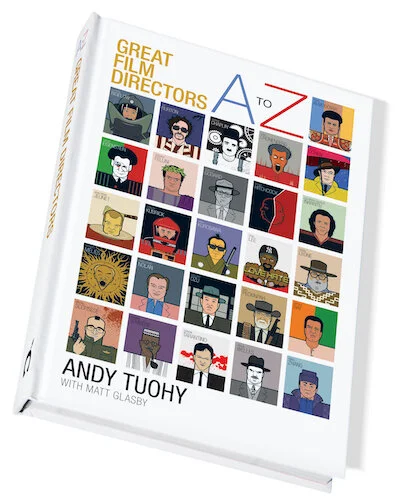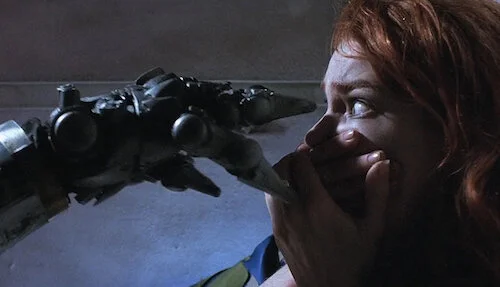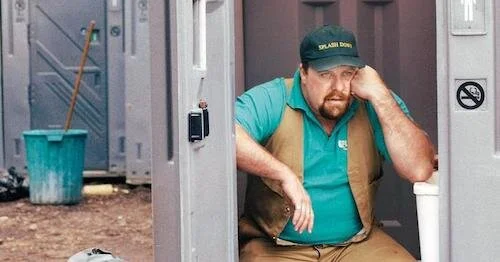Andy Tuohy: Capturing Motion Pictures in Still Illustrations
Conducted by Andreas Babiolakis
Andy Tuohy.
I love all things film, and that includes film related books (historical, coffee table, anything). A blind buy I made two years ago while browsing a local store is A-Z Great Film Directors. The front cover caught my eye when it was on display. I could recognize portraits of so many of my favourite filmmakers; Jean-Luc Godard was in greyscale with a menacing scowl, Pedro Almodóvar was coloured in with Madrilenian primary colours, and David Cronenberg was losing his marbles Scanners style. I couldn’t help but flip through the book and spot many more favourites of mine: Bergman, Ozu, the Archers, Campion, Kurosawa and so on. A-Z is a series by illustrator Andy Tuohy, where gorgeous artworks based on iconic figures are paired up with brief educational texts, recommendations, and more (this series also includes contemporary artists, authors and more). For Great Film Directors, you get five film recommendations for each director. These can be obvious selections for legends (you can guess Spielberg’s, I’m sure), but a deviation towards underrated gems like Zhang Yimou’s Curse of the Golden Flower.
Even if I knew many of the works and directors in this book, it just felt so me. Having these pieces of so many of my favourite auteurs felt like a must-have. I also find the book to be incredibly insightful for budding cinephiles hoping to discover more; the fifty two choices here cover many time periods, genres, and styles. I’ve personally recommended the book to a number of my friends who want to learn more about film in a bite sized, interesting way, and now I’m making this recommendation to you. I am pleased to announce that I was able to talk to Tuohy about this book as well. You can find our chat below. You can also visit the main page of his company Andy Tuohy Design here (as well as prints based on his newest series Gods of Synth, inspired by various electronic music giants), and his Twitter here.
Spike Lee by Andy Tuohy.
Films Fatale: How on earth did you manage to narrow down the list of directors, especially since you were discovering new ones for this project?
Andy Tuohy: Not easy at all. The editor, co-author and I each put forward our choices. Those that we all agreed on were included. Others we made the case for, and some would have been personal choices. I insisted Carpenter was included as I rate him very highly in his genre and Dark Star is one of my favourite films. I don’t think there is any question that all included are great directors, but it needs to be stressed we weren’t saying all are the best either. There are plenty who weren’t included that people might be asking why they weren’t in.
I lost count of how many people wanted Wes Anderson in. With hindsight I wish we had out more female directors in. I think, because not many of them are very high profile it’s easy to sideline women. I’d say it is a valid criticism. Coppola, Varda and Ramsay could all have been in and no one could argue. It’s as well to say the #metoo movement has definitely changed the landscape regarding female representation. People have suggested doing a specific female director’s book.
FF: What was it like researching the important filmmakers you were unfamiliar with, like Yasujirō Ozu? Tons of films being watched? Lots of reading up on them?
AT: It was pretty exhausting. I couldn’t watch every film by every director and some like [Ousmane] Sembene’s films were pretty hard to get hold of so I didn’t get to see. I watched a couple of Ozu’s films. Including Good Morning, which was a lovely film I was so glad I got to watch as I would never have seen it had it not been for the book.
FF: With your modern art and literature books, I feel like you could go wild with the portraits of each figure. Was the director book more constricting or more freeing, since you managed to pinpoint the aesthetic styles and tropes of each filmmaker so specifically?
AT: None were any more or less constricting the others. Just different approaches. Artists was definitely more graphic and minimalist in style. Directors was a progression towards more defined facial features with each portrait representing something to do with their style or film characters.
FF: How do you go about starting each new portrait?
AT: I’d look at the director and see which character in their back catalogue they would look best as or more identifiable as. Good examples being Tim Burton as Beetlejuice or Spielberg as Indiana Jones. It’s fun to look at them and try and work out who they are meant to be.
Some of the directors featured in A-Z Great Film Directors, by Andy Tuohy.
FF: What made you become a cinephile in the first place?
AT: I don’t think I became a cinephile by conscious choice. We are exposed to films from birth and so it is inevitably part of our cultural influences. Sure, there may be a film which crystallizes an interest over and above the normal, but I would call it an evolution which you either become more or less obsessed with as you get older. I have an obsessive personality that wants to know everything about a film: who produced; acted; directed; composed the music; which actor appeared in or directed other films. But, it could just as easily have been about music and art. Actually, I am pretty obsessive about music so it’s probably in my psychological make-up. In short, I guess, I have no idea when I became a cinephile as it’s always been there lurking in my subconscious.
FF: Are you considering more entries in this series? Perhaps musicians or architects or the like?
AT: There won’t be any more with the current publisher, but I am looking into self-publishing a book, when I have enough images, under my Gods of Synth series. I’m a huge fan of electronica, so if it were to be anything that would be it. If a publisher came along and said they’d like to do architects then, of course, I would jump at the chance.
FF: We like to send interviews off with the most basic question, based on why we are all cinephiles. What are your top five films of all time, and why?
1. Hardware
AT: I love this film so much. The whole 2000AD controversy aside, it’s beautifully shot, well-acted and has a great post-apocalyptic cyberpunk aesthetic. Also, I was very much into the industrial scene around the time it came out. Front 242, Nitzer Ebb, anything Al Jourgensen touched and Cabaret Voltaire. Of course, Ministry’s ‘Stigmata’ is used to excellent effect. I’m not sure if it was particularly well received when it came out, but it has grown into a cult classic. I loved Tetsuo (The Iron Man) which is Industrial to the max.
2. Kenny
AT: I’m pretty partial to scatological humour. And this has it by the bucketload. A human and very warm portrait of an everyday Aussie just trying to do a job that everyone thinks is crap and beneath them. Kenny is a man who supplies and maintains portable toilets to all types of functions. Even his dad is disgusted by it. The film has so many brilliant one-liners it’s hard to choose, but this quote sums his predicament up: ‘Funny part is parents look at me and say 'that's not much of a job, is it?'. And I say 'well you had kids'. 'You spent the first two years handling their shit, and you weren't getting paid for that'. Priceless.
3. The Singing Ringing Tree
AT: This might be in because of its impression on me as young kid in the ‘70s. So, it has a special place in my heart. I initially saw it serialized in the 70s on the BBC in black and white. Years later I went to a screening and was astonished to see it had actually been filmed in glorious technicolor. If you weren’t traumatized by the dwarf and giant goldfish, you need to see a therapist.
4. Robocop
AT: “Can you fly Bobby?” One of many great one-liners. Dystopian sci-fi at its best. Just avoid the re-make.
5. Nosferatu the Vampyre
AT: I like films that have a tangible atmosphere of dread. And this has it by the bucketload. It is pretty minimalist and superbly demonstrates how less can be more, especially when compared to the more showy, campy Coppola version of Dracula which is obviously more popcorn, but doesn’t leave as much of a lasting impression. [Klaus] Kinski is perfectly cast as a creature who is haunted and pained by his condition of eternal life despite being a monster. And an honourable mention should be made of Popol Vuh’s portentously gothic soundtrack which perfectly enhances the atmosphere.
Andreas Babiolakis has a Masters degree in Film and Photography Preservation and Collections Management from Ryerson University, as well as a Bachelors degree in Cinema Studies from York University. His favourite times of year are the Criterion Collection flash sales and the annual Toronto International Film Festival.










